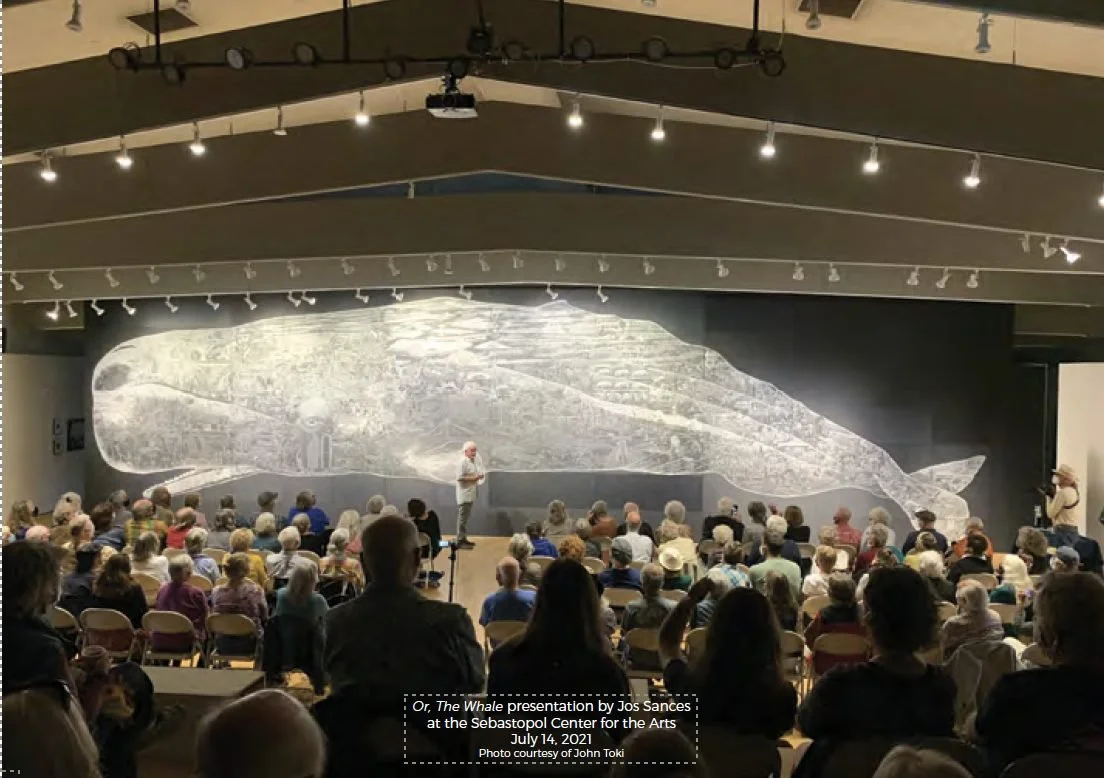Jos Sances and the Vision Behind "Or, The Whale" (Part One)

Introduction
In Or, The Whale, artist Jos Sances merges natural history, political critique, and personal experience into a monumental artwork that confronts the forces shaping contemporary America. Created as a sweeping, 51-foot depiction of a sperm whale whose entire body is filled with hundreds of meticulously drawn scenes, the mural immerses viewers in a visual narrative that moves between ecological wonder and social reckoning. It is both a tribute to the animal at the center of America’s whaling mythology and a piercing examination of the systems that continue to define the Anthropocene.
Few artists navigate these intersections as confidently as Sances—an artist whose work has consistently blended political engagement, community printmaking, and storytelling. Or, The Whale is the culmination of decades of practice, drawing on influences that weave together Baja California’s coastal landscapes, the legacy of political murals, and Herman Melville’s Moby-Dick. The result is an artwork that is at once encyclopedic and deeply personal.
Baja, Todos Santos, and the Origins of the Whale
The genesis of Or, The Whale begins in Todos Santos, Baja California Sur—a region defined by dramatic desert coastlines, dense whale migrations, and tight-knit communities. Sances spent extended time there, absorbing the rhythms of a place where human life remains closely entangled with the ocean. Baja’s working-class harbors, roadside shrines, rugged cliffs, and whale-watching vantage points all appear in fragments across the final mural, grounding the work in memory and lived observation.
As the catalogue text describes, Sances found in Baja not just inspiration but a “framework of lived experience”—a terrain where beauty and vulnerability coexist. The local economy balancing artisanal fishing with tourism, the spiritual atmosphere of desert shrines, and the majesty of surfacing whales all shaped the emotional tone of the final work. The resulting mural carries this imprint: it is both autobiographical and ecological.
The Whale as Historical, Cultural, and Political Symbol
Sances’s choice of a sperm whale is not incidental. Long before Melville, whales were creatures of myth and fear—vast animals whose lives at sea dwarfed humanity’s. The whale symbolizes a space “between fear and respect,” between industrial exploitation and deep awe.
Sances retains this duality. The whale in the mural is a creature of extraordinary beauty, its massive silhouette dominating the gallery wall. But the scenes within its body—industrial ruins, border landscapes, labor histories, environmental violence—serve as a kind of anatomical x-ray of American capitalism. Sances uses the whale not as an allegory of destruction alone, but as a vessel for understanding the complex histories that drive it.
Sances’s Career and the Return to Monumental Form
Or, The Whale marks a return to scale for Sances, who has been active in political printmaking since the 1970s. As a cofounder of Alliance Graphics and a longtime member of Mission Gráfica, he has spent decades working at the fertile intersection of activism and craft. His prints have been acquired by institutions including the Library of Congress, the Smithsonian Museum of American History, and the Oakland Museum of California.
This monumental whale—constructed from thousands of scratchboard lines—channels this lifetime of artistic labor into a single work. Scratchboard, with its luminous whites incised into blackened surfaces, allows for a richness of detail reminiscent of engraving and mid-century illustration. The technique mirrors the mural’s conceptual strategy: revealing hidden layers by cutting through the surface.
A Whale for the Anthropocene
While rooted in personal history and classical literature, Or, The Whale is unmistakably contemporary. The catalogue text emphasizes the Anthropocene—a geological age defined by human impact—as the lens through which Sances views his country’s industrial and political trajectory. Within the whale’s vast silhouette, scenes of extraction, pollution, labor exploitation, and migration form a mosaic of interconnected crises.
In Sances’s hands, the whale becomes an archive of the era: a living container for the stories of communities navigating systems far larger than themselves. Yet the work is not simply elegiac. It is animated by resilience, dignity, and the will to speak truth through art.
Conclusion
Or, The Whale is both a monumental artwork and a personal summation of Jos Sances’s artistic journey. Drawing from Baja’s landscapes, political histories, and the literary legacy of Moby-Dick, Sances has created a mural that brings together the vastness of the ocean with the complexity of the human condition. It is an artwork that viewers encounter not just visually but intellectually—one that asks us to consider what lies beneath the surface of the world we inhabit.
This first essay introduces the foundations of Sances’s vision. In the next installment, we will explore the deep connections between Or, The Whale and Melville’s Moby-Dick—and how Sances repurposes classic literature to illuminate modern political narratives.
